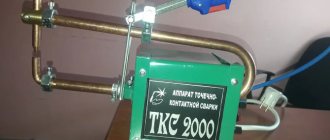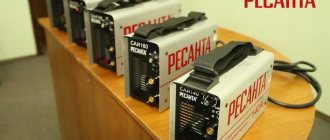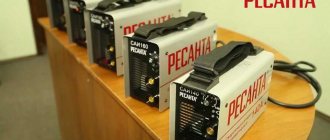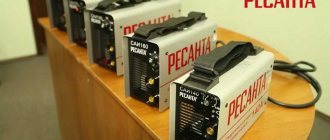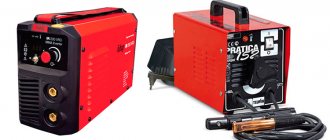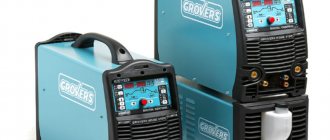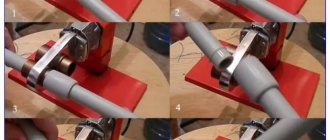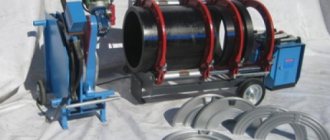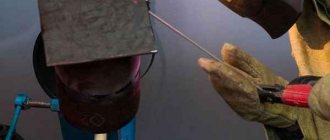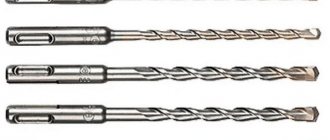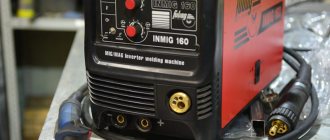Welding metals has been considered the fastest and most reliable connection for many decades. Electric welding, compared to gas welding, is much more preferable and safer, since it does not involve the use of explosive gases - acetylene and oxygen.
Electric welding of metals is carried out by an arc that is formed between the electrodes at low voltage and high current. In older models of welding machines, such an arc was formed by the secondary winding of a step-down transformer. Modern welding machines are electronic devices with double voltage conversion - or inverters.
What it is? Varieties
The general principle of operation of all welding machines is to melt the edges of the workpieces being joined with an electrode, in the process a weld pool is formed. If welding is carried out with a coated electrode or copper-plated wire, then they are also an additive. If a tungsten rod is used, the additive must be supplied manually. Thin sheets can be joined without filler materials.
Simple welding machines consist of a power transformer and a current regulator; inverter circuits involve the use of electronics.
Its purpose:
- Allows you to smoothly regulate the welding current.
- Change the voltage in accordance with other characteristics.
- Maintain stable parameters during welding work.
Modern devices most often use an inverter circuit, the reasons for this are:
- Reduced equipment size – the presence of electronics eliminates the need for large transformers.
- Stable characteristics of the welding arc - the circuit adjusts the parameters during welding.
- Slightly lower requirements for the quality of the electrical network - the inverter circuit consumes less energy.
Expert opinion
Kuznetsov Vasily Stepanovich
The downside is considered to be lower reliability compared to previous generation transformer devices. This applies to all inverters. The second disadvantage is the complex device, which does not allow you to repair equipment without knowledge of electrical circuits.
Craftsmen have learned to restore popular models, but manufacturers do not officially publish schematic diagrams of their welding machines.
For manual arc welding (MAW)
Designed to work with coated electrodes.
Their advantages:
- Simplicity, minimal size and weight.
- Devices that produce a small (up to 190 A) welding current are inexpensive.
- Welding does not require additional materials other than electrodes.
Devices for RDS are the most common and universal. For welding, you will need to purchase coated electrodes, available diameters: 2, 3, 4, 5 mm. Or imported: 2.6 and 3.2 mm.
If the device produces alternating current at the output, then you should purchase electrodes designed for welding with such a device (for example, ANO and similar), and if it is constant, then you can use any: ANO, UCNI, or the like are suitable.
For semi-automatic welding
Welding inverters are suitable for wire welding in carbon dioxide or mixtures.
The advantages of such equipment:
- High welding speed.
- Easy to learn how to work.
- The result is neat seams.
- It is not necessary to beat off the slag crust (it does not form if you use uncoated ordinary wire).
There are also disadvantages: you need to purchase additional equipment. This:
- Gas reducer.
- A hose that can withstand pressure of 2-4 kg/cm.
- Cylinder: volumes of 5, 10, 40 liters are available on sale.
In this regard, it is difficult to carry out welding work in strong winds, carbon dioxide will be blown away, and pores (and other defects) will appear in the seams. Gas will have to be refilled from time to time, and to do this, take the cylinder to the station. Consumption depends on the amount of work and the pressure set on the reducer. Recommended 1-1.5 kg/sq.cm.
Carbon dioxide cylinders are painted gray.
It is possible to cook semi-automatically and without gas, but for this you need to purchase a special cored wire. Sold in small spools of approximately 0.5-0.8 kg. But its cost is almost 2.5 times higher than the price of a regular one including gas.
For argon arc welding (TAW)
The devices are designed for joining non-ferrous alloys: brass, copper, bronze, aluminum, and any others.
The main difference is that the work will require expensive materials:
- Cylinder with gas – argon (Ar+CO2 mixture).
- Non-consumable tungsten electrodes.
- Hose and gas reducer.
- Filler material.
Therefore, the device is worth purchasing if there is an urgent need for welding various alloys. Another unpleasant point: aluminum should be welded with alternating current, while other materials should be welded with direct current. Therefore, you will have to either choose one of the devices, or get a more expensive one - a combined one.
The latter type refers to professional equipment, but manufacturers most often allow RDS mode on such devices. This allows you to save money when connecting steel and cast iron workpieces.
Expert opinion
Kuznetsov Vasily Stepanovich
The last two disadvantages of RAD devices are the difficulty of welding work; it is recommended to practice on thick parts, and you need to learn how to sharpen tungsten correctly.
Recommendations for use
For those who are not familiar with how to start working with the machine, we provide instructions for using the welding machine:
- When welding, be sure to keep a mask in front of your face.
- To light the arc and start welding, you should touch the end of the electrode to the welding site, and the movement along the plane of the workpiece should be like when lighting a match.
- It is not advisable to tap the electrode on the working surface to ignite the arc; this can knock off its coating and subsequently only complicate your task.
- Electrodes for welding must be dry or calcined in accordance with the calcination regime for these electrodes, must be suitable for the type of work being performed, the grade of steel being welded, its thickness, current strength and polarity.
- Welded surfaces must be dry, clean, free of rust and paint.
- When the arc is drawn out, the electrode should be held so that the distance from the end of the electrode to the workpiece is approximately equal to the diameter of the electrode.
- In order to create a uniform seam, this distance must be maintained constantly.
- The inclination of the electrode should be 20-30% relative to the axis of movement.
- When completing the weld, the electrode is pulled back a little so that the welding crater is filled, and then it quickly rises until the arc disappears.
It should be taken into account that at the end of welding on a short electrode, more heat is produced, the electrode heats up more, and burns of the welded metal may appear. You need to be careful when choosing a welding mode.
It is also worth choosing the right type of electrode: in terms of chemical composition, thickness, for longer operation, to obtain a high-quality weld, you need to select the correct filler material.
Which device to choose for your home and garden?
The first stage when choosing a device is determining the scope of work. You also need to understand what metals and alloys need to be welded. The second stage is determining the type of food. If 380 V power is available in a country house, workshop or garage, then it is preferable to buy just such a professional device. In this case, the inverter will operate much more stable than from 220 V.
For large volumes, it is better to purchase a semi-automatic machine; with its help, the process of assembling and welding metal structures will speed up by 2-3 times. If you plan to use the device for small jobs, then it is enough to acquire an RDS inverter of 190-250 Amperes. This is enough for welding (channels, angles, fittings) and for cutting steel, if necessary.
Machines for ADS with manual arc welding mode are the most expensive option, but for small workshops they are the best. Allows you to perform work both for yourself and to order.
What else to pay attention to:
- Indication on the panel - will help novice welders set the required welding current.
- Number of settings – will allow you to fine-tune the parameters during operation.
- Load duration (LOD) – how long (in percentage) the inverter will operate within the cycle (5 minutes). This parameter indicates the rated welding current.
- The type of ignition of a tungsten electrode is contact (by touching the part) and non-contact (the electrode is only brought to a distance from the surface). The second type is better - tungsten will last longer and will not stick.
- Stabilization of the welding arc - helps with voltage surges to keep the current at the desired level and prevent the electrode from sticking.
Expert opinion
Kuznetsov Vasily Stepanovich
If the device is purchased for constant work on the road, then you need to pay attention to the weight, dimensions, and length of the welding cables. The duration of the warranty provided by the manufacturer is also important. A number of companies guarantee trouble-free operation for several years.
No load voltage
This characteristic is sometimes also called “open circuit” voltage. The same voltage level that is supplied by the inverter to the electrodes. This indicator will be different for different welding technologies.
For example, for welding transformers the range is between 45-55 Volts, and for standard inverters it can reach 90 Volts and higher. Semi-automatic welding rarely requires more than 40 volts. The optimal indicator also depends on the type and diameter of the electrodes used.
It is only worth noting that the higher the open circuit voltage, the easier the arc ignites and the more stable the discharge is.
Welding inverter Resanta SAI-220
Popular models. Reviews
It is necessary to consider several common and proven devices of all three types. It is pointless to study the segment of cheap welders, since buying such inverters is a lottery. They can work for just a week, and sometimes for several years without any problems.
If we talk about manufacturing countries, then you should not be afraid of the inscriptions “Made in China”. The vast majority of welding equipment is manufactured in China. Devices assembled in Europe are almost never supplied to Russia, since due to their excessively high cost there is no demand for them.
For RDS
The three best devices according to ratings from various buyers and sellers.
RESANTA SAI-190
- Maximum welding current – 190 A
- Electrode diameter – up to 5 mm
- Weight – 4.7 kg
- Warranty period – 2 years
Even with unstable mains voltage it cooks well. It is better to use MP-3C 3 mm electrodes. Overheat protection.
Cons : short cables.
Wester MINI 220T
- Maximum welding current – 220 A
- Electrode diameter – up to 5 mm
- Weight – 3 kg
- Warranty period – 60 months
Lightweight and powerful device. Digital display on the front panel.
Cons : no handle for transportation.
Fubag IR 180
- Maximum welding current – 180 A
- Electrode diameter – up to 4 mm
- Weight – 4.6 kg
- Warranty period – 2 years
Convenient carrying handle (there is a belt), reliable body, sufficient power for home and garden use.
Content
- Basic classification of inverters
- Advantages of inverters
- Which is better: a welding inverter or a transformer?
- Useful features
- Main characteristics
- Professional models of welding inverters
- Review of welding inverters from well-known manufacturers
A welding inverter is a welding device that currently occupies a leading position in popularity among welders, both experienced and beginners.
These welding devices took all the best from transformers and received an additional number of useful options. Their popularity is justified by the possibility of universal use: from home to production. Welding inverters appeared on the market in the 70s of the last century. They replaced transformers, although they never completely pushed them out of the market. The main features of these devices are compactness, ease of use and accessibility. These characteristics are important for those new to welding. Modern inverters have a number of useful functions that help you quickly master an activity such as welding.
In this article we will analyze in detail how to choose a welding inverter by type and characteristics, as well as the method for selecting a suitable unit.
How to use and maintain correctly
In order for the equipment to last longer, it is necessary to promptly remove the particles that accumulate inside. To remove it, you must either frequently use a powerful vacuum cleaner, blowing dust out of the ventilation slots, or periodically remove the casing and clean the insides manually - with a brush or compressed air.
Before the end of the warranty period, the bolts securing the body panels cannot be unscrewed.
The semi-automatic burner must be cleaned of splashes during operation. It is recommended to treat the nozzle with non-stick compounds: sprays or paste.
You should not cook at maximum current for a long time, this will lead to a decrease in the service life of the device.
Be sure to follow safety precautions: use a protective mask, mittens or leggings. Do not cook near flammable objects. You should always have fire fighting equipment on hand.
Do you already have an inverter welding machine?
Of course! No, but it will be!
Possible problems
Frequently encountered problems:
- The device turned off during welding - modern boards have temperature sensors that turn off the power. Often an indicator with a graphic symbol “Thermometer” lights up on the panel. In such cases, there is no need to turn off the device. The fan will help cool the inside faster.
- During RDS welding, the electrode sticks all the time - the voltage in the network is low, it is not enough for work. You need to turn off all unnecessary electrical appliances, reduce the current on the inverter, and use electrodes of a smaller diameter.
- When welding with a semi-automatic inverter or ADS, pores appear. Or tungsten does not excite the arc - low gas pressure. It is necessary that a flow of carbon dioxide or argon blows over the welding zone. The optimal pressure is 1-1.5 kg/sq.m. cm. For welding aluminum, sometimes a little more is required.
- There is an electric shock from the body of the device - this often happens outdoors in high humidity. You need to ground the device or work on a rubber mat.
If smoke comes out of the ventilation slots or sparks escape, you need to turn off the power and take the inverter to a service center.
The choice of welding inverter depends on what work will have to be performed in the future.
Examine all possible problems that may arise when working with a welding machine.
Also important:
- Professionalism of the future owner.
- How much money is allocated for the purchase?
- For how long is the device needed?
For frequent and varied work, it is better to buy professional equipment.
Operating principle of welding inverters
Inverter-type welding machines operate on the principle of double conversion of the supply voltage. The whole process occurs in several stages:
- Rectification of mains voltage;
- Converting it to high frequency voltage;
- Reducing the voltage value;
- Rectification of the resulting voltage.
The mains voltage of 220/380 volts is supplied through a surge protector to a bridge of powerful silicon diodes, where it is rectified. The filter prevents the penetration of network pulse noise into the electronic circuit of the welding inverter. The ripples of the resulting voltage are smoothed out by high-capacity capacitors.
Next, the direct voltage, about 310 volts, is converted into high-frequency pulsed alternating voltage. Its value can be in the range of 40-80 kHz. Conversion (inversion) is carried out by powerful IGBT or MOSFET semiconductor elements. Due to the dissipation of large amounts of heat, transistor switches are installed on powerful radiators. The inverter operates under the control of a PWM controller.
Pulses from the output of the converter are supplied to the primary winding of the transformer, which is designed to reduce the voltage to the optimal value. The use of high frequency made it possible to achieve very small dimensions of the transformer. If a regular 160A welding transformer weighs about 20 kg, then a pulse welding converter weighs no more than 4 kg.
The last element of the welding inverter circuit is a diode rectifier. Since conventional diodes are not suitable for this frequency, high-speed diode assemblies are used in the rectifier. These can be ordinary elements or Schottky diodes. They are mounted on radiators.
To obtain optimal temperature conditions, a fan is provided in the design of the welding converter. An important element of the inverter circuit is the soft start relay. It consists of a powerful resistor and capacitor and is designed to ensure that the powerful electrical impulse generated when the device is turned on does not “knock out” the diodes of the bridge circuit.
